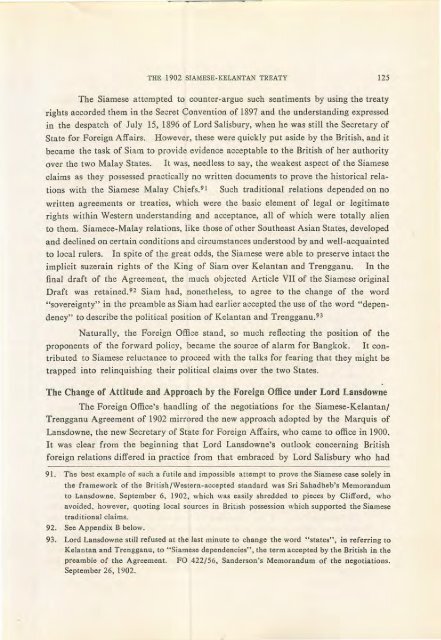The Journal of the Siam Society Vol. LXXII, Part 1-2, 1984 - Khamkoo
The Journal of the Siam Society Vol. LXXII, Part 1-2, 1984 - Khamkoo
The Journal of the Siam Society Vol. LXXII, Part 1-2, 1984 - Khamkoo
Create successful ePaper yourself
Turn your PDF publications into a flip-book with our unique Google optimized e-Paper software.
THE 1902 SIAMESE-KELANTAN TREATY 125<br />
<strong>The</strong> <strong>Siam</strong>ese attempted to counter-argue such sentiments by using <strong>the</strong> treaty<br />
rights accorded <strong>the</strong>m in <strong>the</strong> Secret Convention <strong>of</strong> 1897 and <strong>the</strong> understanding expressed<br />
in <strong>the</strong> despatch <strong>of</strong> July 15, 1896 <strong>of</strong> Lord Salisbury, when he was still <strong>the</strong> Secretary <strong>of</strong><br />
State for Foreign Affairs.<br />
However, <strong>the</strong>se were quickly put aside by <strong>the</strong> British, and it<br />
became <strong>the</strong> task <strong>of</strong> <strong>Siam</strong> to provide evidence acceptable to <strong>the</strong> British <strong>of</strong> her authority<br />
over <strong>the</strong> two Malay States.<br />
It was, needless to say, <strong>the</strong> weakest aspect <strong>of</strong> <strong>the</strong> <strong>Siam</strong>ese<br />
claims as <strong>the</strong>y possessed practically no written documents to prove <strong>the</strong> historical relations<br />
with <strong>the</strong> <strong>Siam</strong>ese Malay Chiefs. 91<br />
Such traditional relations depended on no<br />
written agreements or treaties, which were <strong>the</strong> basic element <strong>of</strong> legal or legitimate<br />
rights within Western understanding and acceptance, all <strong>of</strong> which were totally alien<br />
to <strong>the</strong>m. <strong>Siam</strong>ece-Malay relations, like those <strong>of</strong> o<strong>the</strong>r Sou<strong>the</strong>ast Asian States, developed<br />
and declined on certain conditions and circumstances understood by and well-acquainted<br />
to local rulers. In spite <strong>of</strong> <strong>the</strong> great odds, <strong>the</strong> <strong>Siam</strong>ese were able to preserve intact <strong>the</strong><br />
implicit suzerain rights <strong>of</strong> <strong>the</strong> King <strong>of</strong> <strong>Siam</strong> over Kelantan and Trengganu. In <strong>the</strong><br />
final draft <strong>of</strong> <strong>the</strong> Agreement, <strong>the</strong> much objected Article VII <strong>of</strong> <strong>the</strong> <strong>Siam</strong>ese original<br />
Draft was retained. 92 <strong>Siam</strong> had, none<strong>the</strong>less, to agree to <strong>the</strong> change <strong>of</strong> <strong>the</strong> word<br />
"sovereignty" in <strong>the</strong> preamble as <strong>Siam</strong> had earlier accepted <strong>the</strong> use <strong>of</strong> <strong>the</strong> word "dependency"<br />
to describe <strong>the</strong> political position <strong>of</strong> Kelantan and Treogganu. 9 3<br />
Naturally, <strong>the</strong> Foreign Office stand, so much reflecting <strong>the</strong> position <strong>of</strong> <strong>the</strong><br />
proponents <strong>of</strong> <strong>the</strong> forward policy, became <strong>the</strong> source <strong>of</strong> alarm for Bangkok. It contributed<br />
to <strong>Siam</strong>ese reluctance to proceed with <strong>the</strong> talks for fearing that <strong>the</strong>y might be<br />
trapped into relinquishing <strong>the</strong>ir political claims over <strong>the</strong> two States.<br />
<strong>The</strong> Change <strong>of</strong> Attitude and Approach by <strong>the</strong> Foreign Office under Lord Lansdowne<br />
<strong>The</strong> Foreign Office's handling <strong>of</strong> <strong>the</strong> negotiations for <strong>the</strong> <strong>Siam</strong>ese-Kelantan/<br />
Trengganu Agreement <strong>of</strong> 1902 mirrored <strong>the</strong> new approach adopted by <strong>the</strong> Marquis <strong>of</strong><br />
Lansdowne, <strong>the</strong> new Secretary <strong>of</strong> State for Foreign Affairs, who came to <strong>of</strong>fice in 1900.<br />
It was clear from <strong>the</strong> beginning that Lord Lansdowne's outlook concerning British<br />
foreign relations differed iu practice from that embraced by Lord Salisbury who had<br />
91. <strong>The</strong> best example <strong>of</strong> such a futile and impossible attempt to prove <strong>the</strong> <strong>Siam</strong>ese case solely in<br />
<strong>the</strong> framework <strong>of</strong> <strong>the</strong> British/Western-accepted standard was Sri Sahadheb's Memorandum<br />
to Lansdowne. September 6, 1902, which was easily shredded to pieces by Clifford, who<br />
avoided, however, quoting local sources in British possession which supported <strong>the</strong> <strong>Siam</strong>ese<br />
traditional claims.<br />
92. See Appendix B below.<br />
93. Lord Lansdowne still refused at <strong>the</strong> last minute to change <strong>the</strong> word "states", in referring to<br />
Kelantan and Trengganu, to "<strong>Siam</strong>ese dependencies", <strong>the</strong> term accepted by <strong>the</strong> British in <strong>the</strong><br />
preamble <strong>of</strong> <strong>the</strong> Agreement. FO 422/56, Sanderson's Memorandum <strong>of</strong> <strong>the</strong> negotiations.<br />
September 26, 1902.

















